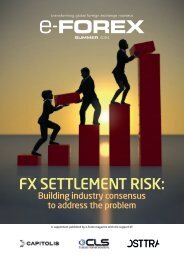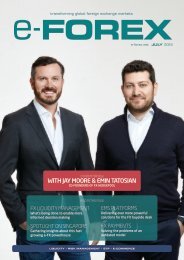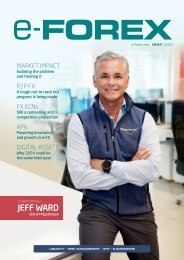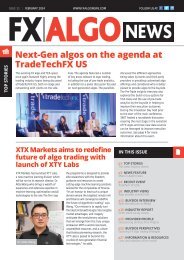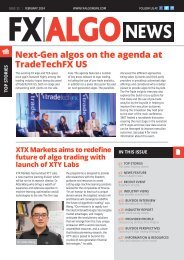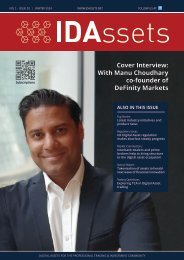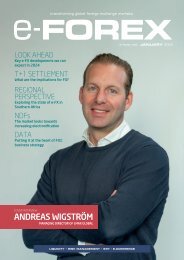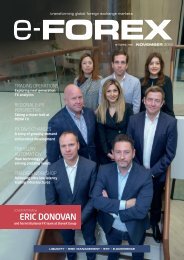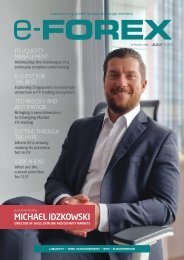Create successful ePaper yourself
Turn your PDF publications into a flip-book with our unique Google optimized e-Paper software.
FX Automation:<br />
Pushing Boundaries<br />
Sebastian Hofmann-Werther, Head of EMEA at 360T, teases<br />
out some of the nuances associated with automated trading<br />
solutions in FX.<br />
Asian currency pairs, but if it has<br />
no overnight desk then it might be<br />
forced to trade in hours when those<br />
pairs are less liquid. Using a set of<br />
completely customisable parameters<br />
this hedge fund could instead autoexecute<br />
these trades at a time when<br />
EXPERT OPINION<br />
Sebastian Hofmann-Werther<br />
In the FX industry people often talk<br />
about “the buy-side” as a collective<br />
group when in fact there is a huge<br />
degree of diversity within this segment<br />
of the marketplace — both in terms of<br />
the structure and operations of these<br />
firms as well as their execution methods<br />
and objectives.<br />
However, over the past few years<br />
we’ve observed one trend that remains<br />
consistent across this heterogenous<br />
group of firms called the buy-side, and<br />
that’s the strong desire to automate<br />
more of their FX activity utilising<br />
execution management systems (EMS).<br />
But because these firms are all different,<br />
so too are their automation priorities.<br />
For example, a very large asset<br />
manager trading on behalf of<br />
thousands of funds might focus<br />
on ways to automatically net off<br />
positions between them all in order<br />
to reduce the overall amount of FX<br />
they have to trade, and thus reduce<br />
costs.<br />
By contrast, a key goal for an<br />
institutional investment manager<br />
trading international equities might<br />
be to minimise the amount of time<br />
between their equity transaction and<br />
the FX trade necessary to facilitate<br />
it, in which case automating the<br />
latter can help achieve this. A hedge<br />
fund in the US might need to trade<br />
liquidity conditions are much more<br />
favourable in order to improve the<br />
pricing available.<br />
A corporate treasurer, meanwhile,<br />
might look to automate parts or<br />
all of their FX workflows in order<br />
to reduce the amount of manual<br />
processing on the desk, freeing up<br />
staff to focus on other more missioncritical<br />
activities and minimising the<br />
operational risks associated with these<br />
processes. Often there are concerns<br />
that the increased automation of<br />
FX execution will negatively impact<br />
treasurers’ relationships with their<br />
bank partners. But contrary to this,<br />
the time which the treasurers save on<br />
manual execution processes opens up<br />
more room for strategic dialogue with<br />
the banks.<br />
Suffice to say, the specific use cases<br />
and benefits of this technology are<br />
myriad, but an overarching theme<br />
amongst every firm that we speak to<br />
is that they are looking for ways to<br />
increase productivity and drive new<br />
efficiencies on the trading desk, and<br />
automation is one way of doing this.<br />
34 MAY 20<strong>23</strong> e-FOREX




